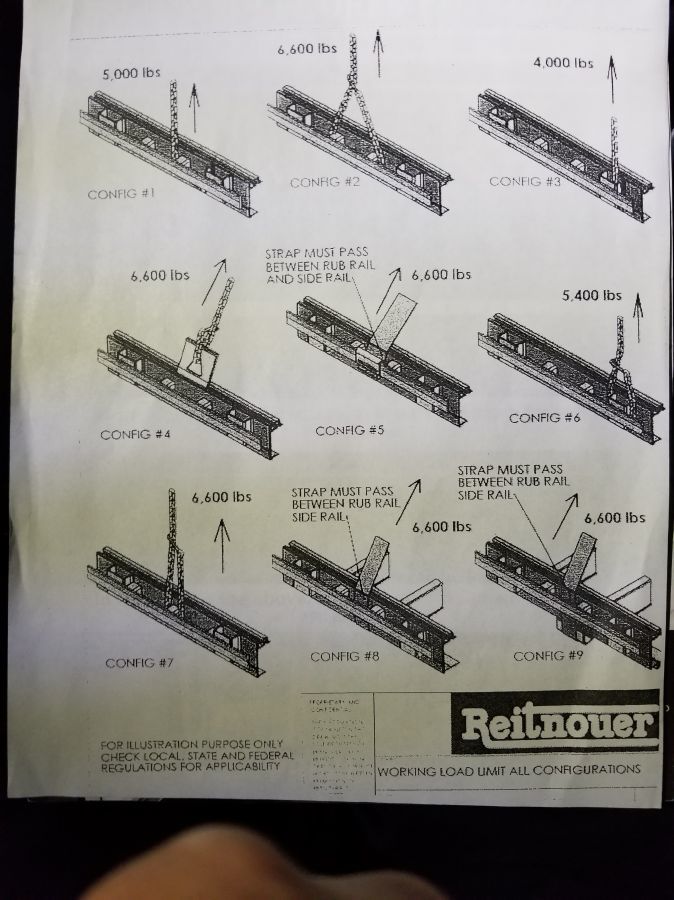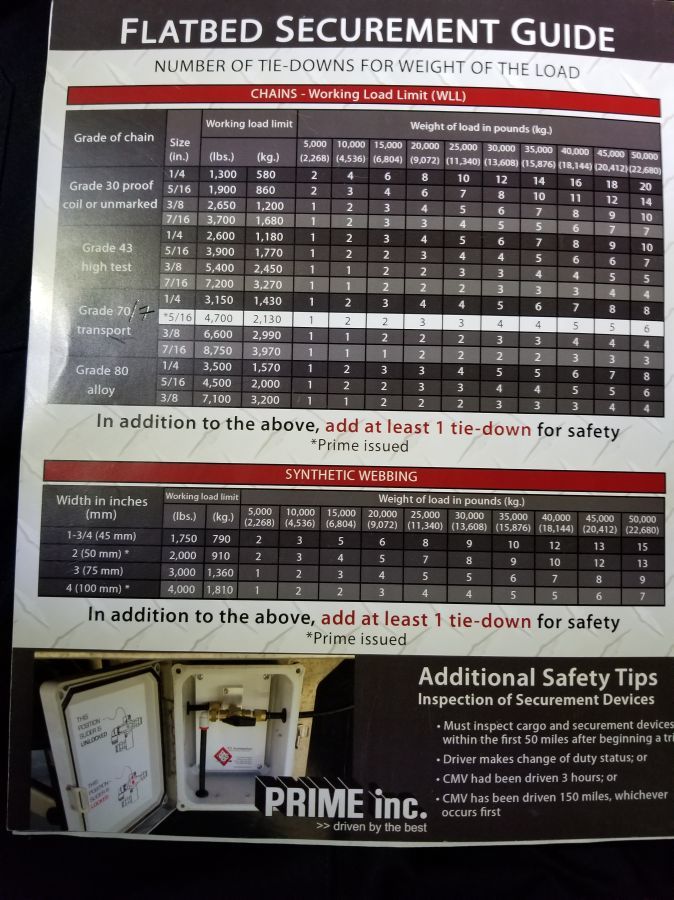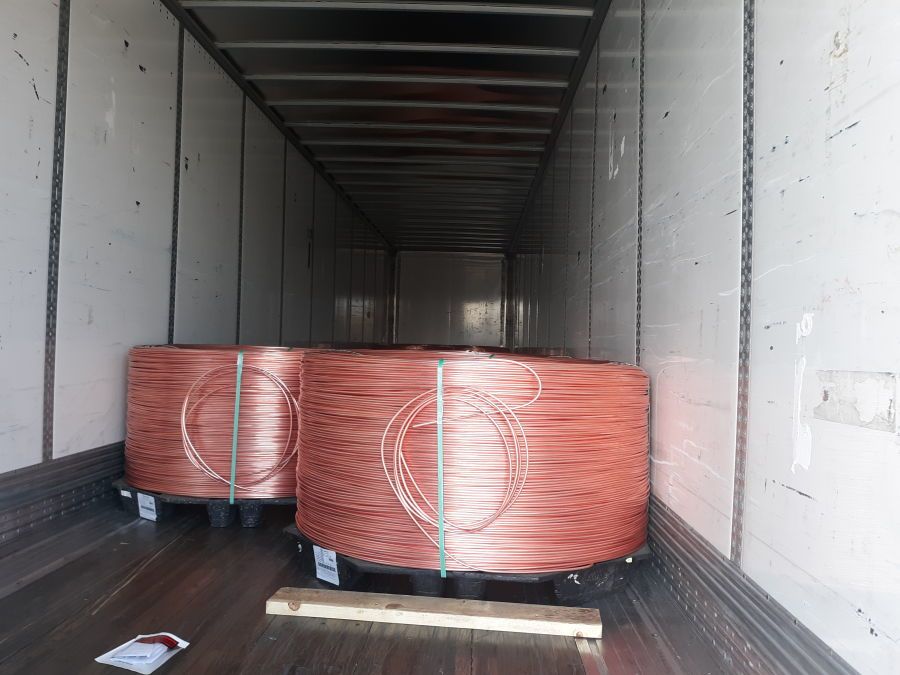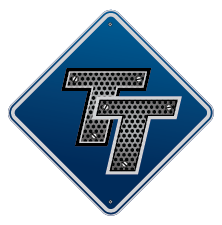If You Over Tighten You Won't Know
Topic 29251 | Page 1
Then the FMCSA Guy added "if you over tighten / secure you will never know". I thought that was a good piece of advice you can never go wrong adding extra securement to the load you are hauling. What say you my fellow flat bed colleagues?
Not that I'm a flatbedder - but there are set specs for WLL and how much securement to use. It goes without saying (or does it?), that throwing a few extra straps isn't going to hurt anything (except for the time it takes to throw/ratchet/remove/stow), and if you get pulled in, too much is always better than too little.
Not all that sure that overtightening does anything more than put extra stress on the straps and helps them wear faster.
Rick
CSA:
Compliance, Safety, Accountability (CSA)
The CSA is a Federal Motor Carrier Safety Administration (FMCSA) initiative to improve large truck and bus safety and ultimately reduce crashes, injuries, and fatalities that are related to commercial motor vehicle
FMCSA:
Federal Motor Carrier Safety Administration
The FMCSA was established within the Department of Transportation on January 1, 2000. Their primary mission is to prevent commercial motor vehicle-related fatalities and injuries.
What Does The FMCSA Do?
- Commercial Drivers' Licenses
- Data and Analysis
- Regulatory Compliance and Enforcement
- Research and Technology
- Safety Assistance
- Support and Information Sharing
Fm:
Dispatcher, Fleet Manager, Driver Manager
The primary person a driver communicates with at his/her company. A dispatcher can play many roles, depending on the company's structure. Dispatchers may assign freight, file requests for home time, relay messages between the driver and management, inform customer service of any delays, change appointment times, and report information to the load planners.OWI:
Operating While Intoxicated
you can never go wrong adding extra securement to the load you are hauling. What say you my fellow flat bed colleagues?
Hey Chris, how are things going for ya?
I agree with the statement saying
as long as all the straps used to secure the load had a WLL of 50% of the total weight of tanker body than the caller was good to go.
Discussions on WLL (working load limits) can get interesting. By the way, here's a little flat bedding trivia for ya. Working Load Limits are determined by the breaking strength of a tie down mechanism. If you want to define the working load limit of a tie down mechanism it is the active amount of stress that mechanism can stand before it fails or breaks. The calculation used to determine the working load limit is 1/3 of the mechanism's breaking strength. A standard 2" strap is rated at a WLL of 3,333 pounds. That means it's breaking strength is 10,000 pounds.
You can always secure loads by a variety of measures, but as the expert on that program pointed out you just need to make sure you are using the proper calculations. It would obviously take more 2" straps than 4" straps to properly secure the tanker in that radio program conversation, but as long as the numbers are right it is safe.
A 4" strap has a WLL rating of 5,400 pounds. I always just used the calculation of 5,000 pounds because it made the math quick and easy to do in my head. I could quickly do the calculation by dividing the weight of my load by 5,000 pounds and know what would make it legal. I always tended to over secure my loads. I always considered it better to be safe than sorry.
Another interesting aspect of load securement is that you need to know what the WLL of your anchor points are. You always calculate your WLL by the weakest link in your overall securement system. So, if you attach your 4" strap to an anchor point that has a WLL of 2,000 pounds, then you only get an effective 2,000 pounds of WLL that you can count on. Most modern flatbed trailers will have a diagram or sticker on them somewhere indicating the various working load limits of the various anchor points available to you.
I also want to remind folks that we have a couple of great training sections in our High Road CDL Training Program that teach load securement. All budding flat-bedders should work their way through those sections. They are excellent. You will learn a lot about how to secure loads so that they are legal and safe. It's also a worthy exercise for those of us who are experienced just to brush up on our understanding of the many load securement requirements and practices. I have always found load securement to be fascinating and challenging. It is one of the aspects of trucking that most drivers don't have to deal with, but it is vital information for anyone hauling open deck freight.
CDL:
Commercial Driver's License (CDL)
A CDL is required to drive any of the following vehicles:
- Any combination of vehicles with a gross combined weight rating (GCWR) of 26,001 or more pounds, providing the gross vehicle weight rating (GVWR) of the vehicle being towed is in excess of 10,000 pounds.
- Any single vehicle with a GVWR of 26,001 or more pounds, or any such vehicle towing another not in excess of 10,000 pounds.
- Any vehicle, regardless of size, designed to transport 16 or more persons, including the driver.
- Any vehicle required by federal regulations to be placarded while transporting hazardous materials.
HOS:
Hours Of Service
HOS refers to the logbook hours of service regulations.Prime gives us this card that lists the WLL for chains and webbing although the 4 inch straps they issue are 5,400 lbs as Old School says.
They also print the Reitnouer WLL for each securement configuration.


I bought 2 3/8 inch chains 25' Long and cut them in half. I have two each on coils weighing 11, 000 and 12, 000 lbs. I used configuration 1. So even though the chain is 6,600 lbs WLL my anchor is only 5,000 lbs. I also have one 4 inch strap on the rear coil more to cinch down the seams on the tarps that for securement. So, I have over 15,000 on the rear coil and 10,000 on the front coil. I have 2 stacks of steel plates that weigh about 22,000 lbs total. I have 3 straps on each bundle.
So total securement for 45,000 lbs of cargo is over 55, 000 lbs.
I just wanted to add that in regards to any strap, it’s rated first by width. A 2” strap is only rated for 2k and a 4” for 4K. Depending on the construction of the strap is where you’ll get the higher ratings with the majority being 5400 and those usually have it printed on the strap along with the tag which needs to be present to certify that rating. I’ve used 4” straps which were rated for 6600 and 7200. Always verify the rating of your equipment and never assume. Adding more securement is never a bad thing that’s for sure. I personally shoot for 100% on every piece of machinery I move but that’s just me and I’m kinda weird like that.
HOS:
Hours Of Service
HOS refers to the logbook hours of service regulations.Hey Chris, how are things going for ya?
Old School:
I'm doing just fine I've settled into the groove of running this dedicated account. I'm running 5 skids of metal coil every night (Sunday to Thursday) from Oswego NY to the aluminum can manufacturing plant in Middletown, NY (If we have any Coors Light drinkers on TT You are welcome....)
 I just updated my running millage tally and I've crossed the 165k milestone since I started up solo back in April '19. Most of my driving is from Oswego to Middletown then back to Oswego with the exception of an occasional run down to U.S. Gypsum in Avenel, NY for a load of pallets of Joint Compound that is how my week goes. This coming year the Wife and I are going to start planning move south hopefully by the fall of '22 So I'm exploring the possibilities of going back over the road for the regional flatbed division because the two places we are considering to move to my company has terminals (Pooler, GA, and Georgetown, SC). Right now I plan to continue to haul coil until I have a full year on this route. I want to get the winter driving experience of hauling heavy 60k+ loads. I keep plugging along.
I just updated my running millage tally and I've crossed the 165k milestone since I started up solo back in April '19. Most of my driving is from Oswego to Middletown then back to Oswego with the exception of an occasional run down to U.S. Gypsum in Avenel, NY for a load of pallets of Joint Compound that is how my week goes. This coming year the Wife and I are going to start planning move south hopefully by the fall of '22 So I'm exploring the possibilities of going back over the road for the regional flatbed division because the two places we are considering to move to my company has terminals (Pooler, GA, and Georgetown, SC). Right now I plan to continue to haul coil until I have a full year on this route. I want to get the winter driving experience of hauling heavy 60k+ loads. I keep plugging along.
Rob D: Next time you get back up to Novelis Oswego, NY - Please look me up I'm always at the Cold Mill loading up usually late afternoon (1500-1800) Sunday through Thursday Look for a Red Freightliner Gypsum Express Truck #16347 I pull a Reitnouer Trippel axel with a Roll - Tight cover. I'll make a note to check where the Cold Mill shipping keeps the metal chain protector clips for the coils. I know that on the Hot Mill Shipping side there is a big crate of the clips along with the timber braces and metal base brackets to secure the timber braces. Also our yard is just around the corner from the East Gate on Oswego County Route 1 Take a right at the 4 Way stop we are down on the left about 1/4 mile. See you down the road Cheers
Terminal:
A facility where trucking companies operate out of, or their "home base" if you will. A lot of major companies have multiple terminals around the country which usually consist of the main office building, a drop lot for trailers, and sometimes a repair shop and wash facilities.
Regional:
Regional Route
Usually refers to a driver hauling freight within one particular region of the country. You might be in the "Southeast Regional Division" or "Midwest Regional". Regional route drivers often get home on the weekends which is one of the main appeals for this type of route.
Over The Road:
Over The Road
OTR driving normally means you'll be hauling freight to various customers throughout your company's hauling region. It often entails being gone from home for two to three weeks at a time.
Chris L wrote:
Rob D: Next time you get back up to Novelis Oswego, NY - Please look me up I'm always at the Cold Mill loading up usually late afternoon (1500-1800) Sunday through Thursday Look for a Red Freightliner Gypsum Express Truck #16347 I pull a Reitnouer Trippel axel with a Roll - Tight cover. I'll make a note to check where the Cold Mill shipping keeps the metal chain protector clips for the coils. I know that on the Hot Mill Shipping side there is a big crate of the clips along with the timber braces and metal base brackets to secure the timber braces. Also our yard is just around the corner from the East Gate on Oswego County Route 1 Take a right at the 4 Way stop we are down on the left about 1/4 mile. See you down the road Cheers
Chris I will definitely look you up next time I'm there. In fact, I would like to see your technique and get some tips on securing coils.
Here's how we secure copper coils:

PackRat: When I was still training my trainer and I did a per-load of wire spools at a place in Rome, NY. The spools were placed on edge then blocked and braced in the trailer.
Rob D: The coils I pick up are already wrapped up on wooden skids with the eye's vertical. Normally I get 5 and load and secure each with 2 nylon ratchet straps for each coil. I haven't loaded large coils on the Cold Mill side; but I have loaded a couple on the Hot Mill side I actually loaded two 22k coils on a flat bed suicide style. It was the first time I loaded "Solo" one of our other drivers was also loading up and he gave me a hand getting the coils secured. It still took me about three hours to get them secured and covered. The tarp job was lacking to say the least I was so embarrassed I told my FM that whoever pick up that load wanted to re-tarp the coils come and get me and I would help get the tarps straight. On of our drivers showed me another way of getting the heavy lumber tarps over the coil. Drag the tarp to the back end of the trailer. Un-roll it then re-roll a quarter of it back up drag the rolled portion to the bace of the coil. The start to un-roll it by pushing it up on the face of the coil to the top edge. Use your strap bar to push it across the top of the coil. From there you can pull it down the front face of the coil and position it where you want it before you un-fold the tarp.
Fm:
Dispatcher, Fleet Manager, Driver Manager
The primary person a driver communicates with at his/her company. A dispatcher can play many roles, depending on the company's structure. Dispatchers may assign freight, file requests for home time, relay messages between the driver and management, inform customer service of any delays, change appointment times, and report information to the load planners.New Reply:
New! Check out our help videos for a better understanding of our forum features

















Preview:








 TT On Facebook
TT On Facebook
I was heading home after a long week and I was listening to the Road Dog channel on SiriusXM. I think the Dave Nemo? Nimo? Show was on and a caller was asking about if the Working Load Limit WLL was determined by the width of the straps you were using. The callers example was strapping a empty tanker body to his lowboy and the straps he used were 2" in width. The question to the guest expert was should the caller have used wider straps? The expert (A former FMCSA official said that as long as all the straps used to secure the load had a WLL of 50% of the total weight of tanker body than the caller was good to go. Then the FMCSA Guy added "if you over tighten / secure you will never know". I thought that was a good piece of advice you can never go wrong adding extra securement to the load you are hauling. What say you my fellow flat bed colleagues?
CSA:
Compliance, Safety, Accountability (CSA)
The CSA is a Federal Motor Carrier Safety Administration (FMCSA) initiative to improve large truck and bus safety and ultimately reduce crashes, injuries, and fatalities that are related to commercial motor vehicle
FMCSA:
Federal Motor Carrier Safety Administration
The FMCSA was established within the Department of Transportation on January 1, 2000. Their primary mission is to prevent commercial motor vehicle-related fatalities and injuries.
What Does The FMCSA Do?
Fm:
Dispatcher, Fleet Manager, Driver Manager
The primary person a driver communicates with at his/her company. A dispatcher can play many roles, depending on the company's structure. Dispatchers may assign freight, file requests for home time, relay messages between the driver and management, inform customer service of any delays, change appointment times, and report information to the load planners.